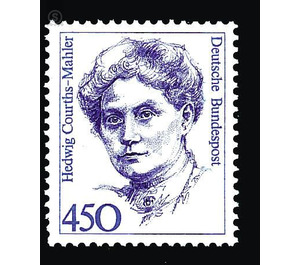Permanent series: Women of German History - Germany / Federal Republic of Germany 1992 - 450 Pfennig
Theme: Health & Human
| Country | Germany / Federal Republic of Germany |
| Issue Date | 1992 |
| Face Value | 450.00 |
| Color | white blue |
| Perforation | K 14 |
| Printing Type | 2-color Typography |
| Stamp Type | Postage stamp |
| Item Type | Stamp |
| Chronological Issue Number | 1487 |
| Chronological Chapter | GER-BRD |
| SID | 631790 |
| In 45 Wishlists | |
A few years ago, when literary studies gave up its voluntary fixation on high literature and increasingly turned to the widely read but also much-vilified entertainment literature, it rediscovered a writer who had preserved a loyal audience right up to the present: more than 200 novels matter Hedwig Courths-Mahler is one of the most prolific authors of German, and with a total circulation of more than 50 million copies she was and is by far the most successful. The fact that many of her books have been filmed and some recently adapted for television underscores her continued popularity. Hedwig (actually: Ernestine Friederike Elisabeth) Courths-Mahler was born on 18 February 1867 as an illegitimate child in Nebra on the Unstrut. The father died before her birth, and the stepfather fell a few years later in the German-French War. After she had had to drop out of school at the age of twelve, she worked in Leipzig as a housemaid and later as a lecturer - a first early contact with literature, which encouraged her to become a literary artist himself. Her great role model was entertainer Eugenie Marlitt, whom she would surpass in the decades ahead in terms of both productivity and popular appeal. At first, however, the great success was delayed; It was not until 1905 that her first novel - "Light and Shadow" - was published in sequels in the "Chemnitzer Tageblatt". Thus, the breakthrough was in sight, the literary career unstoppable. In the next few years Roman followed Roman; the name Courths-Mahler became a quality label for entertainment literature. Titles such as "I Will not Leave You" (1912) and "Griseldis" (1916) are representative of the wealth of novels, which differ in content and form, with which they inspired their predominantly female audience and wrote down their own fortune. In 1905 the family moved to Berlin; After the seizure of power of the National Socialists, which the author faced decidedly distanced, she retired to her estate on Lake Tegernsee. Here she died on November 26, 1950, after she had been literary until 1948. But what made Hedwig Courths-Mahler's novels so attractive to a less literary audience? First and foremost, this is that she consciously responded to the wishes and needs of her readers, that she thus satisfied her secret desires for a perfect world, in which good prevails, virtue is rewarded, and heroine comes to a truly good conclusion her lover is united. This, however, guaranteed the necessary widespread effect, but did not promote acceptance of literary criticism, which complained about the schematism of the course of action and the typification of the characters. The fact that in this way the social status quo is cemented and that every wish for change is discredited has been reprimanded above all in the recent decades. The author herself hardly met this criticism. Given her undeniable broad appeal, she could afford the sovereign insight of writing "harmless fairy tales for tall children" that would "give her audience a few carefree hours." And why should not such self-restraint, which rhymes with nothing but pain, be among the legitimate rights of literature? (Text: Dr. Markus Krause, Königswinter)


